Comprehensive Analysis of Work Health and Safety Legislation
VerifiedAdded on 2023/06/15
|7
|1854
|190
Report
AI Summary
This report provides a comprehensive overview of Work Health and Safety (WHS) 2011, a harmonized act designed to ensure the health and safety of employees and associated individuals. It discusses key aspects of health and safety legislation, including regulations on work hours, rest periods, and leave entitlements, emphasizing the importance of written agreements and employee rights. The report outlines processes for identifying hazards in the workplace, such as analyzing past incidents, consulting with workers, and examining work premises, along with procedures for monitoring risk control. It highlights the significance of providing information to work teams regarding risks and hazards, enabling their active participation in risk management. Effective consultative mechanisms are explored, emphasizing employee motivation and direct participation in health and safety decisions. Finally, the report explains the hierarchy of control, a prioritized list of control applications for eliminating or reducing threats, detailing the steps involved in hazard identification, risk assessment, and control implementation. The conclusion emphasizes the global application of WHS acts in developing work culture and the importance of monitoring procedures to ensure workforce health and safety.
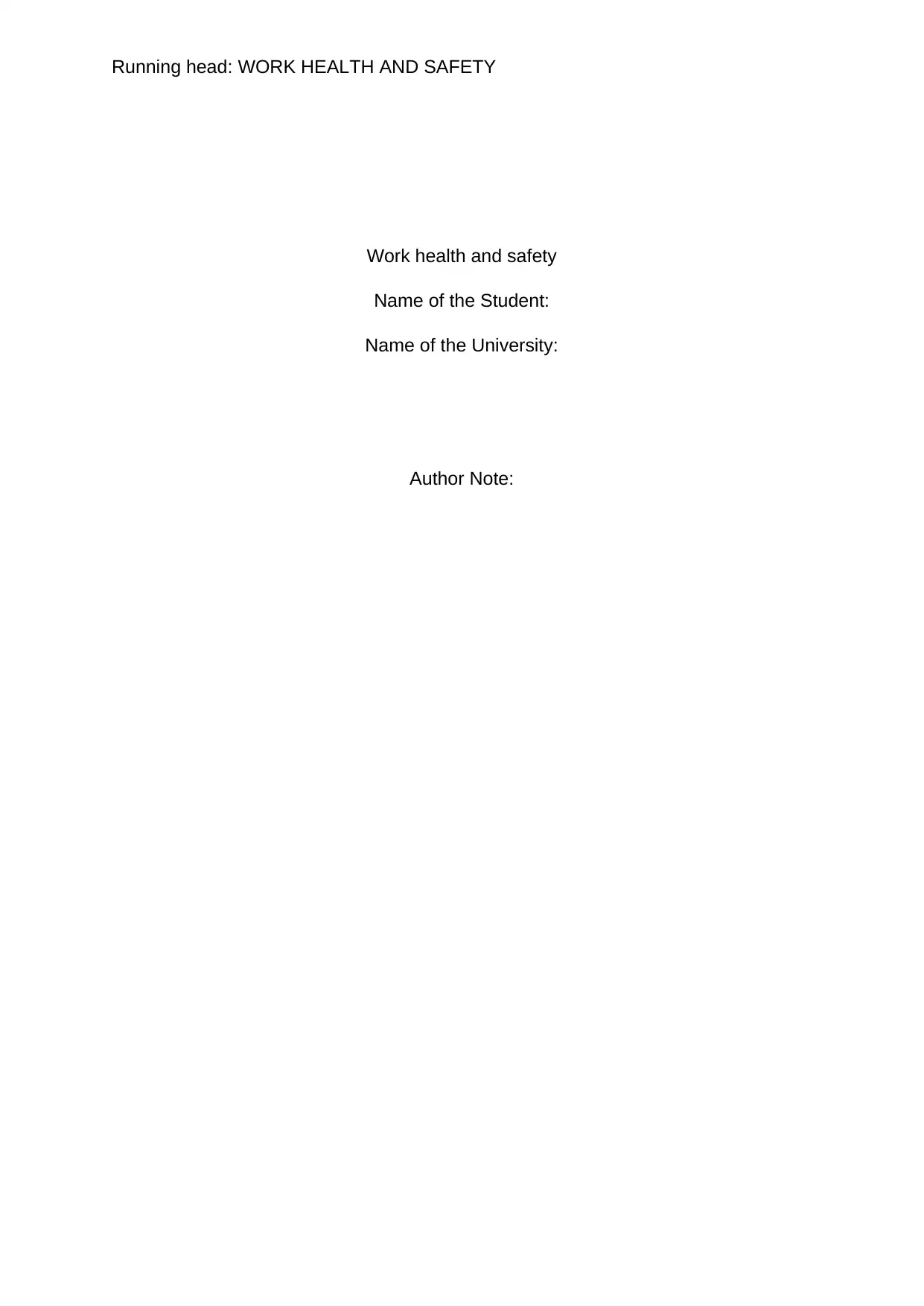
Running head: WORK HEALTH AND SAFETY
Work health and safety
Name of the Student:
Name of the University:
Author Note:
Work health and safety
Name of the Student:
Name of the University:
Author Note:
Paraphrase This Document
Need a fresh take? Get an instant paraphrase of this document with our AI Paraphraser
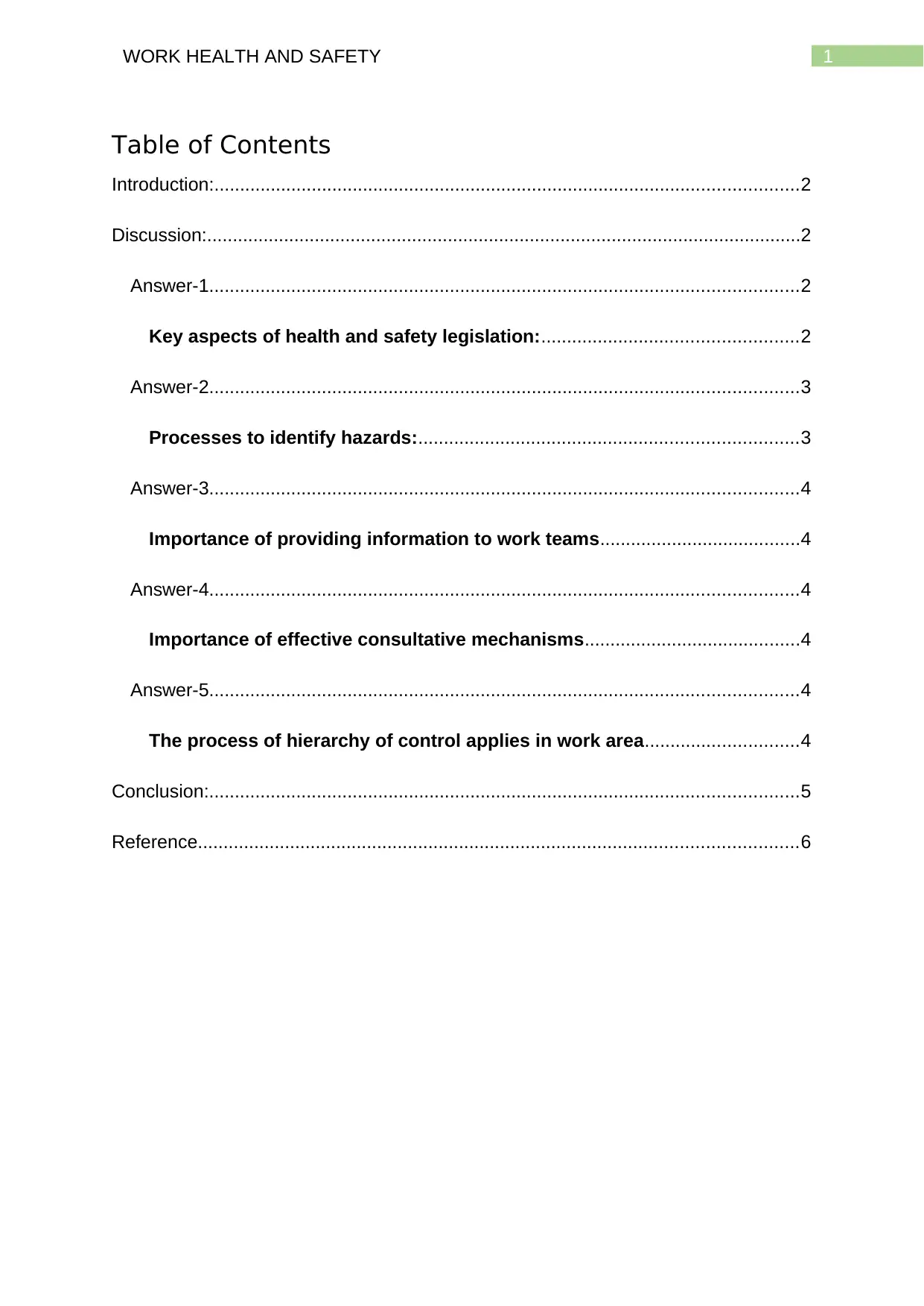
1WORK HEALTH AND SAFETY
Table of Contents
Introduction:..................................................................................................................2
Discussion:....................................................................................................................2
Answer-1...................................................................................................................2
Key aspects of health and safety legislation:..................................................2
Answer-2...................................................................................................................3
Processes to identify hazards:..........................................................................3
Answer-3...................................................................................................................4
Importance of providing information to work teams.......................................4
Answer-4...................................................................................................................4
Importance of effective consultative mechanisms..........................................4
Answer-5...................................................................................................................4
The process of hierarchy of control applies in work area..............................4
Conclusion:...................................................................................................................5
Reference.....................................................................................................................6
Table of Contents
Introduction:..................................................................................................................2
Discussion:....................................................................................................................2
Answer-1...................................................................................................................2
Key aspects of health and safety legislation:..................................................2
Answer-2...................................................................................................................3
Processes to identify hazards:..........................................................................3
Answer-3...................................................................................................................4
Importance of providing information to work teams.......................................4
Answer-4...................................................................................................................4
Importance of effective consultative mechanisms..........................................4
Answer-5...................................................................................................................4
The process of hierarchy of control applies in work area..............................4
Conclusion:...................................................................................................................5
Reference.....................................................................................................................6
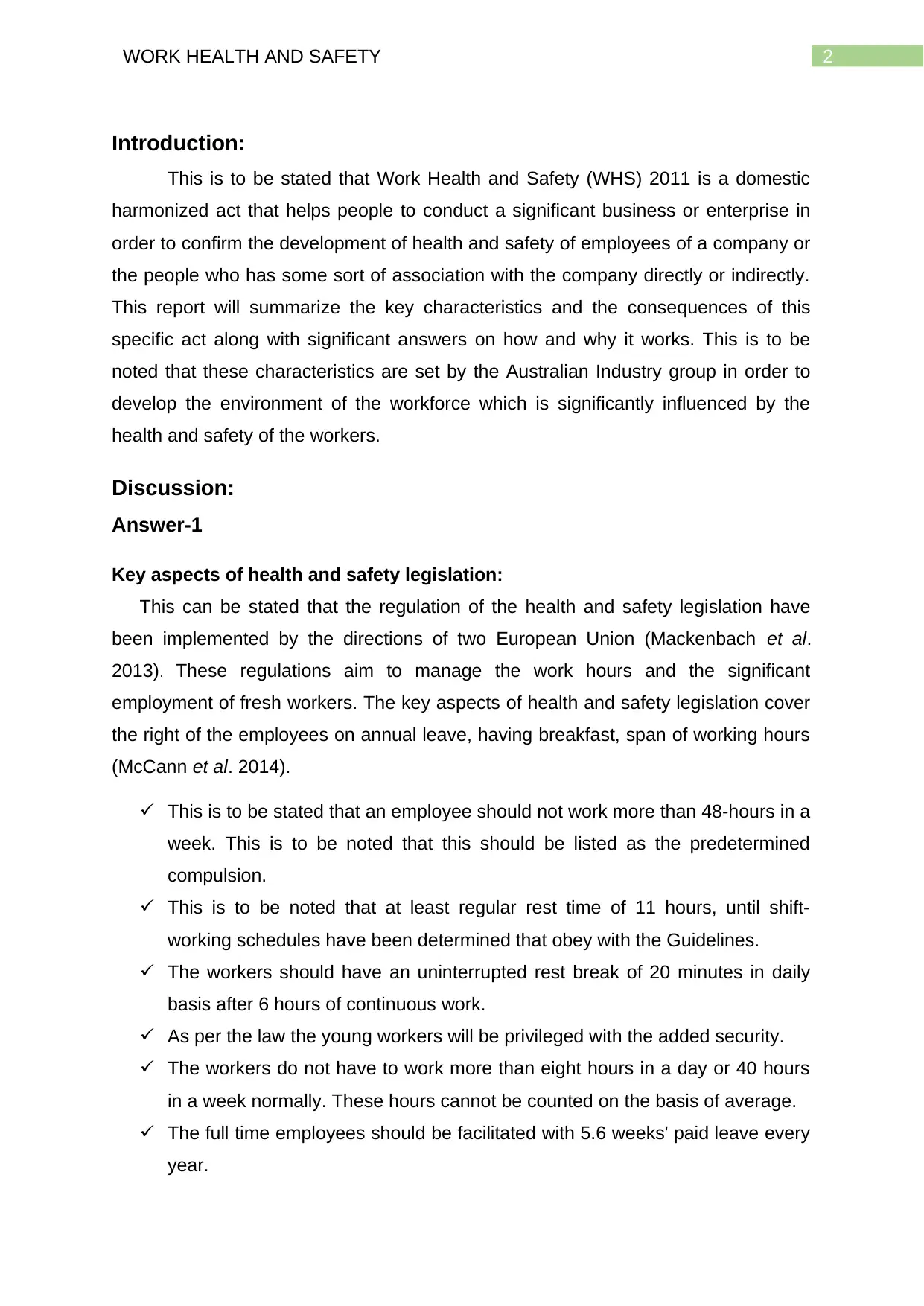
2WORK HEALTH AND SAFETY
Introduction:
This is to be stated that Work Health and Safety (WHS) 2011 is a domestic
harmonized act that helps people to conduct a significant business or enterprise in
order to confirm the development of health and safety of employees of a company or
the people who has some sort of association with the company directly or indirectly.
This report will summarize the key characteristics and the consequences of this
specific act along with significant answers on how and why it works. This is to be
noted that these characteristics are set by the Australian Industry group in order to
develop the environment of the workforce which is significantly influenced by the
health and safety of the workers.
Discussion:
Answer-1
Key aspects of health and safety legislation:
This can be stated that the regulation of the health and safety legislation have
been implemented by the directions of two European Union (Mackenbach et al.
2013). These regulations aim to manage the work hours and the significant
employment of fresh workers. The key aspects of health and safety legislation cover
the right of the employees on annual leave, having breakfast, span of working hours
(McCann et al. 2014).
This is to be stated that an employee should not work more than 48-hours in a
week. This is to be noted that this should be listed as the predetermined
compulsion.
This is to be noted that at least regular rest time of 11 hours, until shift-
working schedules have been determined that obey with the Guidelines.
The workers should have an uninterrupted rest break of 20 minutes in daily
basis after 6 hours of continuous work.
As per the law the young workers will be privileged with the added security.
The workers do not have to work more than eight hours in a day or 40 hours
in a week normally. These hours cannot be counted on the basis of average.
The full time employees should be facilitated with 5.6 weeks' paid leave every
year.
Introduction:
This is to be stated that Work Health and Safety (WHS) 2011 is a domestic
harmonized act that helps people to conduct a significant business or enterprise in
order to confirm the development of health and safety of employees of a company or
the people who has some sort of association with the company directly or indirectly.
This report will summarize the key characteristics and the consequences of this
specific act along with significant answers on how and why it works. This is to be
noted that these characteristics are set by the Australian Industry group in order to
develop the environment of the workforce which is significantly influenced by the
health and safety of the workers.
Discussion:
Answer-1
Key aspects of health and safety legislation:
This can be stated that the regulation of the health and safety legislation have
been implemented by the directions of two European Union (Mackenbach et al.
2013). These regulations aim to manage the work hours and the significant
employment of fresh workers. The key aspects of health and safety legislation cover
the right of the employees on annual leave, having breakfast, span of working hours
(McCann et al. 2014).
This is to be stated that an employee should not work more than 48-hours in a
week. This is to be noted that this should be listed as the predetermined
compulsion.
This is to be noted that at least regular rest time of 11 hours, until shift-
working schedules have been determined that obey with the Guidelines.
The workers should have an uninterrupted rest break of 20 minutes in daily
basis after 6 hours of continuous work.
As per the law the young workers will be privileged with the added security.
The workers do not have to work more than eight hours in a day or 40 hours
in a week normally. These hours cannot be counted on the basis of average.
The full time employees should be facilitated with 5.6 weeks' paid leave every
year.
⊘ This is a preview!⊘
Do you want full access?
Subscribe today to unlock all pages.

Trusted by 1+ million students worldwide
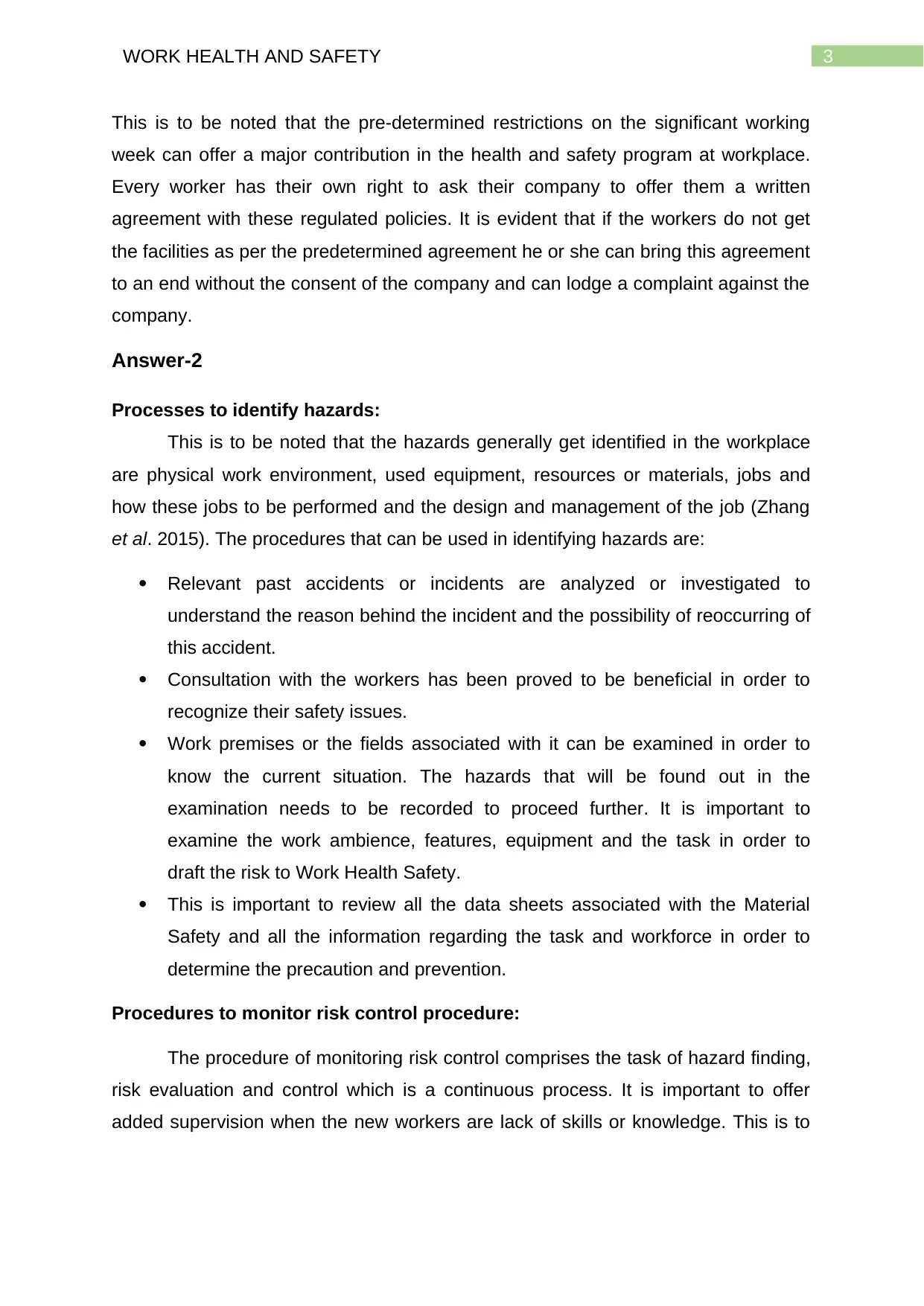
3WORK HEALTH AND SAFETY
This is to be noted that the pre-determined restrictions on the significant working
week can offer a major contribution in the health and safety program at workplace.
Every worker has their own right to ask their company to offer them a written
agreement with these regulated policies. It is evident that if the workers do not get
the facilities as per the predetermined agreement he or she can bring this agreement
to an end without the consent of the company and can lodge a complaint against the
company.
Answer-2
Processes to identify hazards:
This is to be noted that the hazards generally get identified in the workplace
are physical work environment, used equipment, resources or materials, jobs and
how these jobs to be performed and the design and management of the job (Zhang
et al. 2015). The procedures that can be used in identifying hazards are:
Relevant past accidents or incidents are analyzed or investigated to
understand the reason behind the incident and the possibility of reoccurring of
this accident.
Consultation with the workers has been proved to be beneficial in order to
recognize their safety issues.
Work premises or the fields associated with it can be examined in order to
know the current situation. The hazards that will be found out in the
examination needs to be recorded to proceed further. It is important to
examine the work ambience, features, equipment and the task in order to
draft the risk to Work Health Safety.
This is important to review all the data sheets associated with the Material
Safety and all the information regarding the task and workforce in order to
determine the precaution and prevention.
Procedures to monitor risk control procedure:
The procedure of monitoring risk control comprises the task of hazard finding,
risk evaluation and control which is a continuous process. It is important to offer
added supervision when the new workers are lack of skills or knowledge. This is to
This is to be noted that the pre-determined restrictions on the significant working
week can offer a major contribution in the health and safety program at workplace.
Every worker has their own right to ask their company to offer them a written
agreement with these regulated policies. It is evident that if the workers do not get
the facilities as per the predetermined agreement he or she can bring this agreement
to an end without the consent of the company and can lodge a complaint against the
company.
Answer-2
Processes to identify hazards:
This is to be noted that the hazards generally get identified in the workplace
are physical work environment, used equipment, resources or materials, jobs and
how these jobs to be performed and the design and management of the job (Zhang
et al. 2015). The procedures that can be used in identifying hazards are:
Relevant past accidents or incidents are analyzed or investigated to
understand the reason behind the incident and the possibility of reoccurring of
this accident.
Consultation with the workers has been proved to be beneficial in order to
recognize their safety issues.
Work premises or the fields associated with it can be examined in order to
know the current situation. The hazards that will be found out in the
examination needs to be recorded to proceed further. It is important to
examine the work ambience, features, equipment and the task in order to
draft the risk to Work Health Safety.
This is important to review all the data sheets associated with the Material
Safety and all the information regarding the task and workforce in order to
determine the precaution and prevention.
Procedures to monitor risk control procedure:
The procedure of monitoring risk control comprises the task of hazard finding,
risk evaluation and control which is a continuous process. It is important to offer
added supervision when the new workers are lack of skills or knowledge. This is to
Paraphrase This Document
Need a fresh take? Get an instant paraphrase of this document with our AI Paraphraser
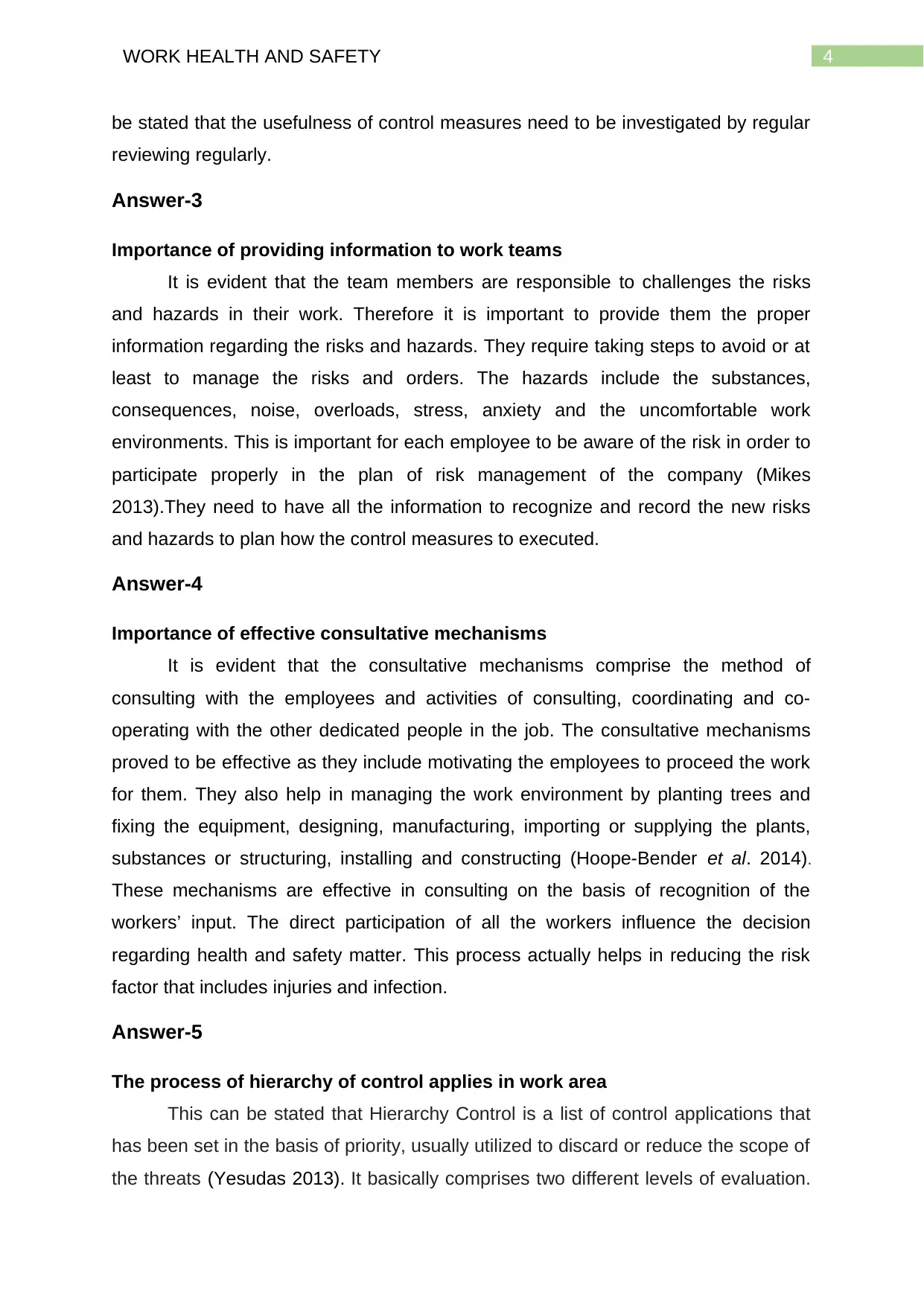
4WORK HEALTH AND SAFETY
be stated that the usefulness of control measures need to be investigated by regular
reviewing regularly.
Answer-3
Importance of providing information to work teams
It is evident that the team members are responsible to challenges the risks
and hazards in their work. Therefore it is important to provide them the proper
information regarding the risks and hazards. They require taking steps to avoid or at
least to manage the risks and orders. The hazards include the substances,
consequences, noise, overloads, stress, anxiety and the uncomfortable work
environments. This is important for each employee to be aware of the risk in order to
participate properly in the plan of risk management of the company (Mikes
2013).They need to have all the information to recognize and record the new risks
and hazards to plan how the control measures to executed.
Answer-4
Importance of effective consultative mechanisms
It is evident that the consultative mechanisms comprise the method of
consulting with the employees and activities of consulting, coordinating and co-
operating with the other dedicated people in the job. The consultative mechanisms
proved to be effective as they include motivating the employees to proceed the work
for them. They also help in managing the work environment by planting trees and
fixing the equipment, designing, manufacturing, importing or supplying the plants,
substances or structuring, installing and constructing (Hoope-Bender et al. 2014).
These mechanisms are effective in consulting on the basis of recognition of the
workers’ input. The direct participation of all the workers influence the decision
regarding health and safety matter. This process actually helps in reducing the risk
factor that includes injuries and infection.
Answer-5
The process of hierarchy of control applies in work area
This can be stated that Hierarchy Control is a list of control applications that
has been set in the basis of priority, usually utilized to discard or reduce the scope of
the threats (Yesudas 2013). It basically comprises two different levels of evaluation.
be stated that the usefulness of control measures need to be investigated by regular
reviewing regularly.
Answer-3
Importance of providing information to work teams
It is evident that the team members are responsible to challenges the risks
and hazards in their work. Therefore it is important to provide them the proper
information regarding the risks and hazards. They require taking steps to avoid or at
least to manage the risks and orders. The hazards include the substances,
consequences, noise, overloads, stress, anxiety and the uncomfortable work
environments. This is important for each employee to be aware of the risk in order to
participate properly in the plan of risk management of the company (Mikes
2013).They need to have all the information to recognize and record the new risks
and hazards to plan how the control measures to executed.
Answer-4
Importance of effective consultative mechanisms
It is evident that the consultative mechanisms comprise the method of
consulting with the employees and activities of consulting, coordinating and co-
operating with the other dedicated people in the job. The consultative mechanisms
proved to be effective as they include motivating the employees to proceed the work
for them. They also help in managing the work environment by planting trees and
fixing the equipment, designing, manufacturing, importing or supplying the plants,
substances or structuring, installing and constructing (Hoope-Bender et al. 2014).
These mechanisms are effective in consulting on the basis of recognition of the
workers’ input. The direct participation of all the workers influence the decision
regarding health and safety matter. This process actually helps in reducing the risk
factor that includes injuries and infection.
Answer-5
The process of hierarchy of control applies in work area
This can be stated that Hierarchy Control is a list of control applications that
has been set in the basis of priority, usually utilized to discard or reduce the scope of
the threats (Yesudas 2013). It basically comprises two different levels of evaluation.
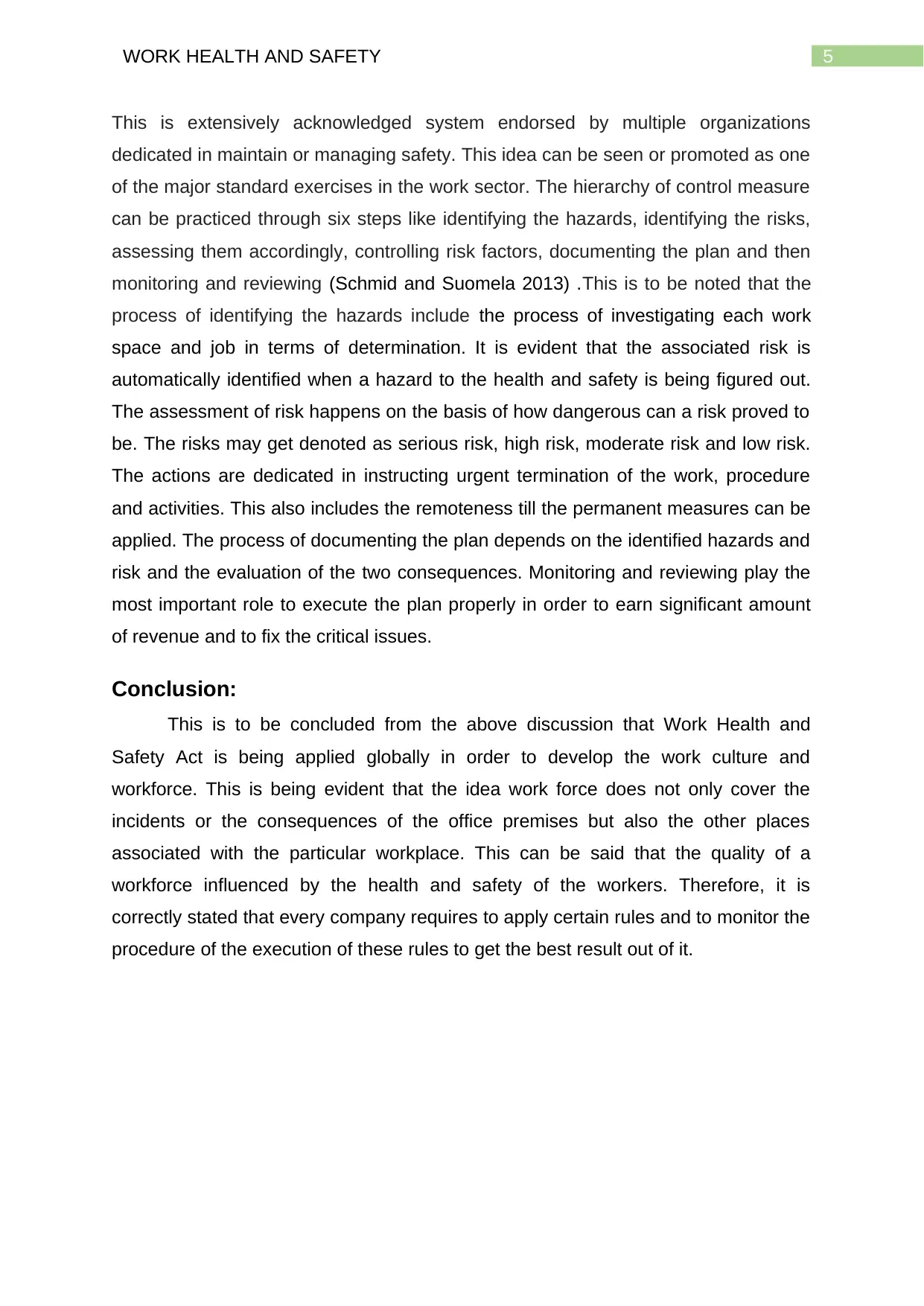
5WORK HEALTH AND SAFETY
This is extensively acknowledged system endorsed by multiple organizations
dedicated in maintain or managing safety. This idea can be seen or promoted as one
of the major standard exercises in the work sector. The hierarchy of control measure
can be practiced through six steps like identifying the hazards, identifying the risks,
assessing them accordingly, controlling risk factors, documenting the plan and then
monitoring and reviewing (Schmid and Suomela 2013) .This is to be noted that the
process of identifying the hazards include the process of investigating each work
space and job in terms of determination. It is evident that the associated risk is
automatically identified when a hazard to the health and safety is being figured out.
The assessment of risk happens on the basis of how dangerous can a risk proved to
be. The risks may get denoted as serious risk, high risk, moderate risk and low risk.
The actions are dedicated in instructing urgent termination of the work, procedure
and activities. This also includes the remoteness till the permanent measures can be
applied. The process of documenting the plan depends on the identified hazards and
risk and the evaluation of the two consequences. Monitoring and reviewing play the
most important role to execute the plan properly in order to earn significant amount
of revenue and to fix the critical issues.
Conclusion:
This is to be concluded from the above discussion that Work Health and
Safety Act is being applied globally in order to develop the work culture and
workforce. This is being evident that the idea work force does not only cover the
incidents or the consequences of the office premises but also the other places
associated with the particular workplace. This can be said that the quality of a
workforce influenced by the health and safety of the workers. Therefore, it is
correctly stated that every company requires to apply certain rules and to monitor the
procedure of the execution of these rules to get the best result out of it.
This is extensively acknowledged system endorsed by multiple organizations
dedicated in maintain or managing safety. This idea can be seen or promoted as one
of the major standard exercises in the work sector. The hierarchy of control measure
can be practiced through six steps like identifying the hazards, identifying the risks,
assessing them accordingly, controlling risk factors, documenting the plan and then
monitoring and reviewing (Schmid and Suomela 2013) .This is to be noted that the
process of identifying the hazards include the process of investigating each work
space and job in terms of determination. It is evident that the associated risk is
automatically identified when a hazard to the health and safety is being figured out.
The assessment of risk happens on the basis of how dangerous can a risk proved to
be. The risks may get denoted as serious risk, high risk, moderate risk and low risk.
The actions are dedicated in instructing urgent termination of the work, procedure
and activities. This also includes the remoteness till the permanent measures can be
applied. The process of documenting the plan depends on the identified hazards and
risk and the evaluation of the two consequences. Monitoring and reviewing play the
most important role to execute the plan properly in order to earn significant amount
of revenue and to fix the critical issues.
Conclusion:
This is to be concluded from the above discussion that Work Health and
Safety Act is being applied globally in order to develop the work culture and
workforce. This is being evident that the idea work force does not only cover the
incidents or the consequences of the office premises but also the other places
associated with the particular workplace. This can be said that the quality of a
workforce influenced by the health and safety of the workers. Therefore, it is
correctly stated that every company requires to apply certain rules and to monitor the
procedure of the execution of these rules to get the best result out of it.
⊘ This is a preview!⊘
Do you want full access?
Subscribe today to unlock all pages.

Trusted by 1+ million students worldwide
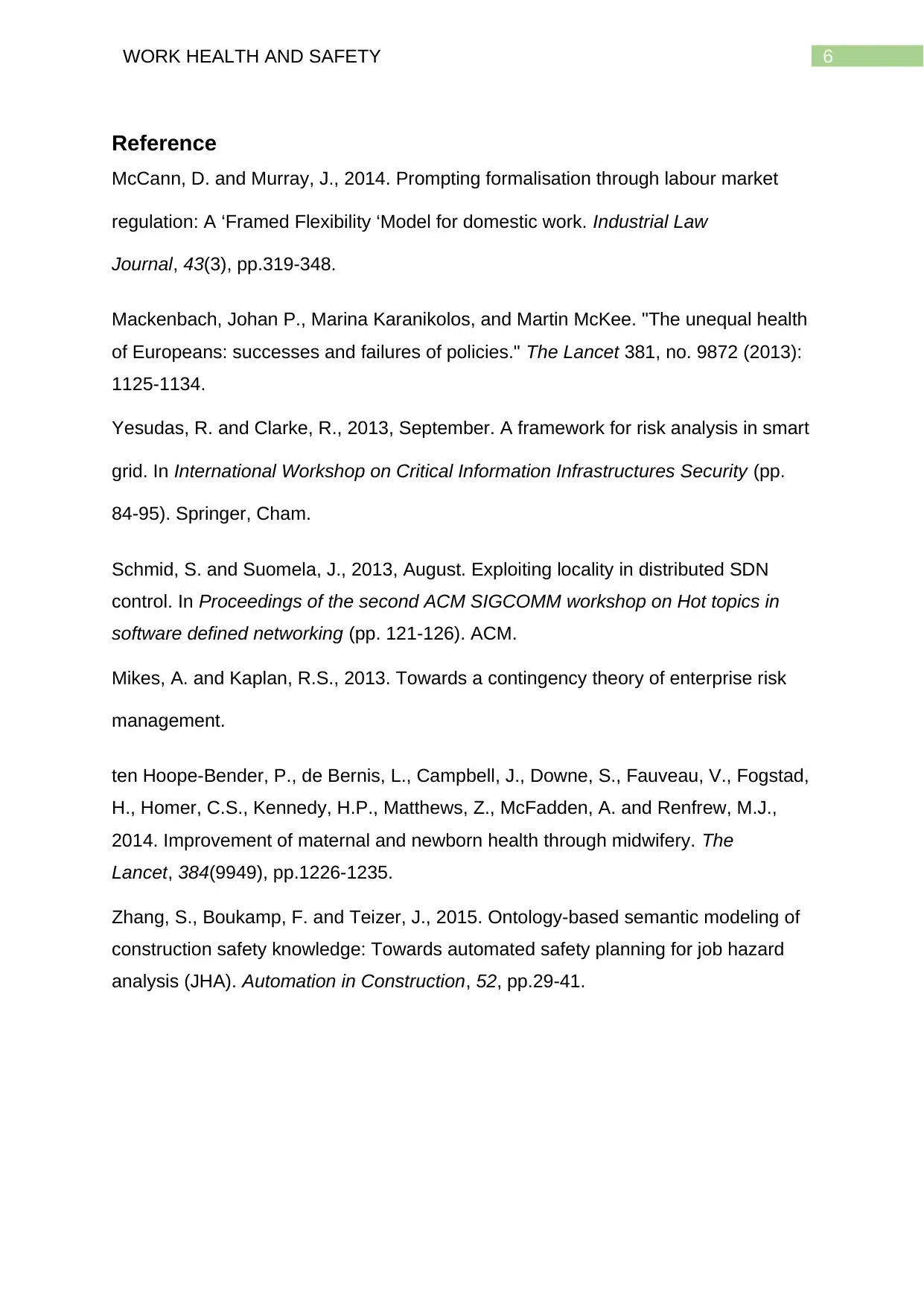
6WORK HEALTH AND SAFETY
Reference
McCann, D. and Murray, J., 2014. Prompting formalisation through labour market
regulation: A ‘Framed Flexibility ‘Model for domestic work. Industrial Law
Journal, 43(3), pp.319-348.
Mackenbach, Johan P., Marina Karanikolos, and Martin McKee. "The unequal health
of Europeans: successes and failures of policies." The Lancet 381, no. 9872 (2013):
1125-1134.
Yesudas, R. and Clarke, R., 2013, September. A framework for risk analysis in smart
grid. In International Workshop on Critical Information Infrastructures Security (pp.
84-95). Springer, Cham.
Schmid, S. and Suomela, J., 2013, August. Exploiting locality in distributed SDN
control. In Proceedings of the second ACM SIGCOMM workshop on Hot topics in
software defined networking (pp. 121-126). ACM.
Mikes, A. and Kaplan, R.S., 2013. Towards a contingency theory of enterprise risk
management.
ten Hoope-Bender, P., de Bernis, L., Campbell, J., Downe, S., Fauveau, V., Fogstad,
H., Homer, C.S., Kennedy, H.P., Matthews, Z., McFadden, A. and Renfrew, M.J.,
2014. Improvement of maternal and newborn health through midwifery. The
Lancet, 384(9949), pp.1226-1235.
Zhang, S., Boukamp, F. and Teizer, J., 2015. Ontology-based semantic modeling of
construction safety knowledge: Towards automated safety planning for job hazard
analysis (JHA). Automation in Construction, 52, pp.29-41.
Reference
McCann, D. and Murray, J., 2014. Prompting formalisation through labour market
regulation: A ‘Framed Flexibility ‘Model for domestic work. Industrial Law
Journal, 43(3), pp.319-348.
Mackenbach, Johan P., Marina Karanikolos, and Martin McKee. "The unequal health
of Europeans: successes and failures of policies." The Lancet 381, no. 9872 (2013):
1125-1134.
Yesudas, R. and Clarke, R., 2013, September. A framework for risk analysis in smart
grid. In International Workshop on Critical Information Infrastructures Security (pp.
84-95). Springer, Cham.
Schmid, S. and Suomela, J., 2013, August. Exploiting locality in distributed SDN
control. In Proceedings of the second ACM SIGCOMM workshop on Hot topics in
software defined networking (pp. 121-126). ACM.
Mikes, A. and Kaplan, R.S., 2013. Towards a contingency theory of enterprise risk
management.
ten Hoope-Bender, P., de Bernis, L., Campbell, J., Downe, S., Fauveau, V., Fogstad,
H., Homer, C.S., Kennedy, H.P., Matthews, Z., McFadden, A. and Renfrew, M.J.,
2014. Improvement of maternal and newborn health through midwifery. The
Lancet, 384(9949), pp.1226-1235.
Zhang, S., Boukamp, F. and Teizer, J., 2015. Ontology-based semantic modeling of
construction safety knowledge: Towards automated safety planning for job hazard
analysis (JHA). Automation in Construction, 52, pp.29-41.
1 out of 7
Related Documents
Your All-in-One AI-Powered Toolkit for Academic Success.
+13062052269
info@desklib.com
Available 24*7 on WhatsApp / Email
![[object Object]](/_next/static/media/star-bottom.7253800d.svg)
Unlock your academic potential
Copyright © 2020–2025 A2Z Services. All Rights Reserved. Developed and managed by ZUCOL.





